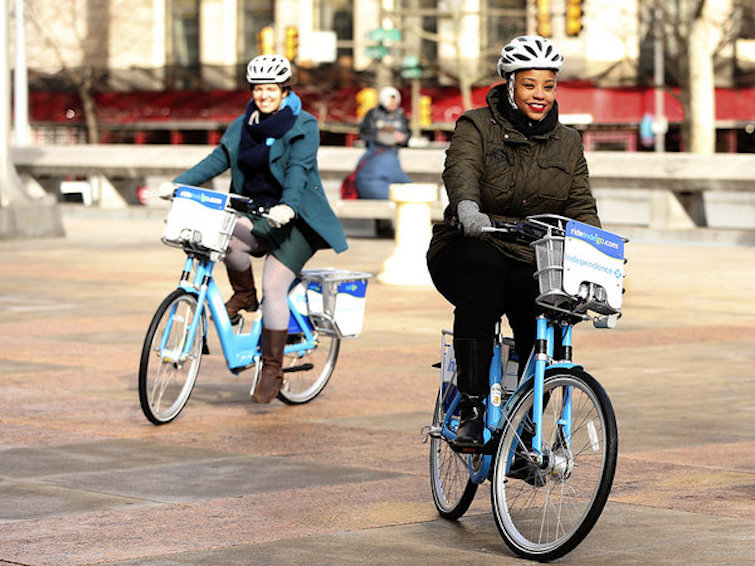Indego Bike Share cruises to 180,000 rides in first 100 days

Barely a month since it surpassed 100,000 rides in record time, Philadelphia’s bike share system, Indego, shows no signs of slowing down.
The new system dealt out over 180,000 rides in its first one hundred days, putting an end to the great depression local bike enthusiasts felt while watching other cities get bike share before Philly. (Speaking of new deals, walk-up half-hour rides are only $1 on the first Tuesday of every month; they are usually $4.)
PlanPhilly recently sat down with Aaron Ritz and Cara Ferrentino – the bicycle program manager and strategic initiatives manager at the Mayor’s Office of Transportation and Utilities, respectively – to get an update on the objectively popular program and a sneak peak at its Phase 2 expansion that they are already beginning to plan.
Indego hit 100,000 about 60 days after launch and blew past 180,000 at 100 days, which means bike share has only gotten more popular as Philadelphians grow more familiar with it.
To date, over 33,000 unique riders have given Indego a spin – that includes walk-up riders and members. Daily ridership averages around 1,800, fluctuating between 1,500 and 2,200. The bikes average about 3 rides a day, which is up from 2 rides a day a month after the launch.
MOTU, or at least Ritz and Ferrentino, really wants to hear from you, the public, as they plan Indego’s expansion. They literally asked for it: “In the article, we’d love it if you could… release the nerds, I guess,” said Ritz, asking PlanPhilly to include his and Ferrentino’s email addresses in this article. “People in neighborhoods know their neighborhood better than we would: where people go, where they shop, and where there is space.” So fire away at (aaron.ritz@phila.gov and cara.ferrentino@phila.gov).
“That’s how we found Darien and Catharine,” added Ferrentino, referring to the recently expanded Indego station in Bella Vista that’s now the largest in the city. MOTU would have never even considered a small side street like Darien without a Bella Vista resident’s suggestion.
“We really appreciate being invited to community association meetings,” said Ferrentino. MOTU wants to talk with local residents “about where they would like bike share, where it would be the most useful and compatible with the surrounding neighborhood.”
Local input is vital, said Ritz, due to the intense difficulty in finding good locations for stations. A station requires a minimum length of 60 feet, at least a 12-foot wide sidewalk (or other publically accessible, off-street space) and, preferably, a decent amount of sunshine (the stations are solar powered).
MOTU and Bicycle Transit Systems, the third-party contractor that manages Indego’s day-to-day operations, have only begun to dig into the reams of data the ride share system produces.
One of the first sets of hard numbers the team’s looked at has been how frequently the stations have been empty or full. An empty or full station acts as “an indication of latent demand,” said Ferrentino. “What trips might have taken place had a bike—or a dock—been available?”
Based off that indicator of station popularity, MOTU added docks to the Indego stations at Darien and Catharine Streets, and Front and Carpenter Streets. They will also soon add stations to the frequently full Foglietta Plaza, better known to most Philadelphians as That Place Across Columbus Boulevard From The Spruce Street Harbor Park.
Just because a station is used a lot doesn’t mean it’s begging for expansion. The Rittenhouse Square station is also one of the top-used, but because it services a mix of commuters heading to work, nearby employees taking lunch trips and tourists, that station rarely becomes full of bikes or empty.
There are other very popular stations that lack expansion options due to space constraints and existing street infrastructure like telephone poles and fire hydrants. The Indego station at 23rd Street and South, next to the Gray’s Ferry Triangle, is a top five spot in terms of ride traffic, but they’ve already crammed as many docks as possible there. Adding another station nearby to alleviate that demand will be a priority as the team inches towards Indego’s Phase 2 expansion.
“The two goals are increasing range and increasing reliability,” said Ritz. Range means pushing further north, south and west with more stations, and reliability means filling neighborhood holes (like Society Hill, which currently lacks a station) and adding more stations to heavily used stations like Gray’s Ferry Triangle.
Ritz said another of the expansion priorities would be more access to the Schuylkill River, and mentioned the possibility of adding a large station near the Falls Bridge.
The Phase 2 expansion will see the system grow to 1,800 bicycles across 180 locations, just under three times the number of bikes (650) and stations (72) available today. With the exception of smaller tweaks – a few docks here, a new station there, and a trickle of new bikes – the expansion won’t start in earnest until next spring.
While the Independence Blue Cross sponsorship and city funds have the operational budget set for the next few years, MOTU is still working on securing capital funds for the expansion.
MOTU, with support from the Bicycle Coalition of Greater Philadelphia, continues to reach out to low and moderate income communities and communities of color to promote Indego.
Indego is the only bike share program in the United States that offers a cash option for memberships, a feature aimed at lower income residents who lack credit or debit cards. So far, about one percent of members use the cash option. But those riders make up four percent of total rides, said Ritz. “People who chose to pay in cash are using the system, and use it well.”
Despite some concerns, bicycle theft has not been a problem, said Ferrentino.
WHYY is your source for fact-based, in-depth journalism and information. As a nonprofit organization, we rely on financial support from readers like you. Please give today.



